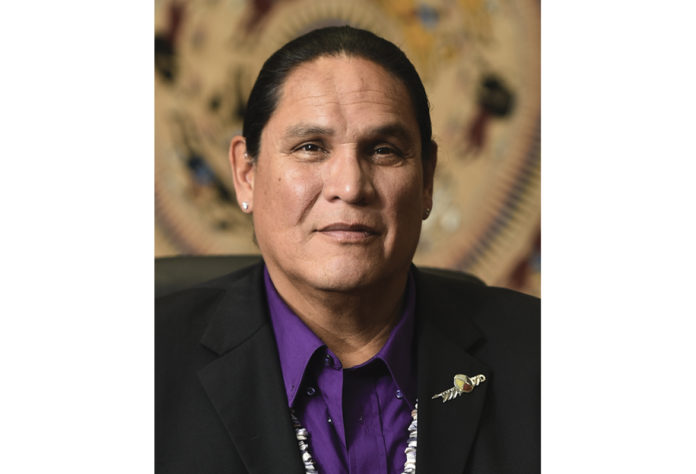by Ernest L. Stevens, Jr.
Native communities nationwide applauded passage of the $1.2 trillion Infrastructure Investment and Jobs Act, which sends approximately $13 billion in direct funding to tribal governments. The welcome infusion of federal funding directs funding to improve broadband coverage on Indian lands, fix roads and bridges, address longstanding water and sanitation needs, improve cybersecurity and critical infrastructure, limit the risk of wildfires, and implement tribal water settlement agreements. The Administration is engaging in a series of consultations with tribal leaders to develop plans to allocate the funding.
The Infrastructure Investment and Jobs Act is by far the largest investment in Indian Country infrastructure in history. These investments will help Indian tribes reverse generations of neglect and help build resiliency in our communities. They also hold great potential to increase job growth and small business development on Indian lands nationwide. However, Congress must act to unlock this potential and enable tribal governments to leverage these investments through targeted tax reform measures. Taking this next step to reform the Tax Code will strengthen tribal government-private sector partnerships and provide a more sustainable means for tribes to access needed capital investment.
The U.S. Tax Code provides broad tools to state and local governments to spur investment in infrastructure projects. For most of the past century, the Tax Code has empowered state and local governments to issue tax exempt bonds. Other federal incentives available to state, local and territorial governments include the Low-Income Housing Tax Credit and New Markets Tax Credit programs, the Build American Bonds program, and many others. State and local governments have utilized these programs to promote economic development, increase employment opportunities, and build critical infrastructure to address community needs. However, these same tools for economic development are not available to tribal governments.
The Low-Income Housing Tax Credit program (LIHTC) is a glaring example of the failure to recognize the governmental status of Indian tribes. For more than thirty years, the LIHTC has been the most significant producer of affordable housing in the U.S. However, tribal governments have been essentially shut out of the LIHTC program. Congress enacted the LIHTC Program in 1986 to provide market incentives to invest in affordable rental housing. The LIHTC enables state and local governments to competitively issue tax credits to developers. The annual expense credits for the LIHTC program is approximately $7 billion annually, making the program one of the largest corporate tax programs administered by the federal government. All 50 states, Washington D.C., and U.S. territories and possessions have housing finance agencies that receive LIHTC allocations. Indian tribes are the only sovereigns not to receive a direct LIHTC allocation, despite the fact that Native Americans are counted towards a state’s population for LIHTC purposes. This oversight has fed into the housing crisis on Indian lands where there is an estimated need for 33,000 housing units on Indian lands to alleviate overcrowding, and an additional 35,000 units to replace existing housing in grave condition. More than 30% of American Indian families live in overcrowded housing – a rate six times the national average.
The New Markets Tax Credit program (NMTC) is another glaring example of the U.S. Tax Code leaving Indian Country behind. Congress established the NMTC program in 2000. Each year, Congress sets the amount of credit available to state and local governments, which the Treasury then allocates to qualified applicants. From 2003 through 2020, the program has parceled out tax credits for a wide variety of economic and community development projects that range from construction of schools, hospitals, and community facilities to retail, manufacturing, and forestry facilities. Since its first round of allocations in 2002, the NMTC program has made 594 awards totaling $30 billion for projects in all 50 states, the District of Columbia, and Puerto Rico through the program. Only 18 awards totaling $977 million in allocations – 0.03 percent – have gone to organizations that plan to invest some or all of the funds on Indian lands.
The impacts of these oversights have led to Indian Country suffering some of the highest unemployment rates in the nation, the lack of small business development, and crumbling infrastructure. The debate in Congress to address this issue is gaining momentum. In March of 2020, the House Ways and Means Committee held an oversight hearing – the first in nearly 40 years – to focus on the need to reform the Tax Code to elevate the governmental status of Indian tribes. In September of 2021, the House-passed version of the Build Back Better initiative included provisions to broaden tribal government tax-exempt bonding authority and provide set-asides for Indian tribes in both the LIHTC and NMTC programs. But more must be done to see these proposals enacted into law.
As we enter the Second Session of the 117th Congress, Indian Country must make a united effort to educate all Members of Congress about this longstanding need to amend the Tax Code to elevate and respect the governmental status of Indian tribes. Providing tribal governments with access to these critical tools for economic development will build on the historic investments in tribal infrastructure, spur tribal government-private sector partnerships to implement these infrastructure investments, and provide tribes with a sustainable means of rebuilding our communities for generations to come.
Ernest L. Stevens, Jr. is Chairman of the National Indian Gaming Association. He can be reached by calling (202) 546-7711 or visit www.indiangaming.org.














































